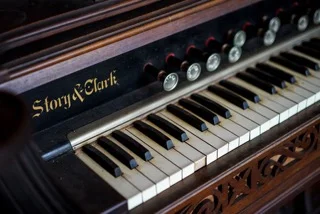When I began working for Hurricane Island last summer, one of the first things I noticed was the strong sense of community on the island. The returning staff members made every effort to make us feel welcome from day one, cheering as we arrived at the dock, and holding hands to share a quote during Dinner Circle. I quickly learned how I could be a part of the community and help others feel welcome as they joined us on Hurricane.
My first impressions of community grew a couple weeks later, as I led my first week of programming with Middle School Marine Ecology. I remember reflecting that our whole community of staff came together to deliver the program, and that’s how it is for many programs on Hurricane: lobstering with Oakley, measuring scallops with Bailey and Jessie, rock climbing with Sam, and learning from Jenn about her graduate school research on crabs.
Vinalhaven students team up for a challenge on Hurricane Island.
What I did not realize last season was the extent to which the Hurricane Island community extends beyond the physical island. When I started working for Hurricane in a year-round capacity this winter, I recognized ways that Hurricane is a part of broader communities, from providing aquaculture education for teachers with Island Institute and Herring Gut Learning Center, to reaching families at the statewide Maine Science Festival.
This year, I was lucky to be involved one of the collaborations, as Hurricane participated in a year-long community partnership focusing on scallop aquaculture education. We teamed up with Vinalhaven Land Trust, Vinalhaven Fisherman’s Co-op, and Vinalhaven School to provide monthly in-school programming for Vinalhaven students, before field trips to Hurricane at the end of the year.
As Hurricane’s year-round Science Educator, I enjoyed developing the curriculum and going into the school each month, working with Vinalhaven teachers to meet the learning goals of each class. The teachers prepared students before each visit and often continued instruction in subsequent class days, maximizing continuity and integrating scallop aquaculture into the science classes all year.
The project involved bringing juvenile scallops to the classrooms, so students could measure and monitor scallop growth. During the year, these scallops were generously housed at Vinalhaven Fisherman’s Co-op, growing in a lantern net off the dock.
Stretch this lantern net vertically to make room for baby scallops!
Vinalhaven Land Trust was instrumental, supporting the project both financially and logistically. Land Trust staff and volunteers not only transported Hurricane staff members between the ferry and the school, they also transported the baby scallops from the Co-op to school each month, and cleaned the lantern nets as they accumulated excess algal growth.
The year-long program culminated in field trips to Hurricane. Students visited our aquaculture site and compared our local conditions to those at the Co-op. They also synthesized growth data from the Vinalhaven scallops and the Hurricane scallops which our research team has measured each month. Finally, a trip to Hurricane is not complete without some island hikes!
Middle school students hike through "The Other Crack."
I enjoyed the monthly visits to Vinalhaven, and I feel lucky to work for an organization that values these collaborations. Without the support of the School, Co-op, and Land Trust, we would not have had an opportunity to work with these students continually throughout the school year. These collaborations, while requiring time and energy to coalesce, have far-reaching potential. I look forward to seeing how the Hurricane community can continue to grow, and to see how we can be involved in communities beyond our 125 acre island.














